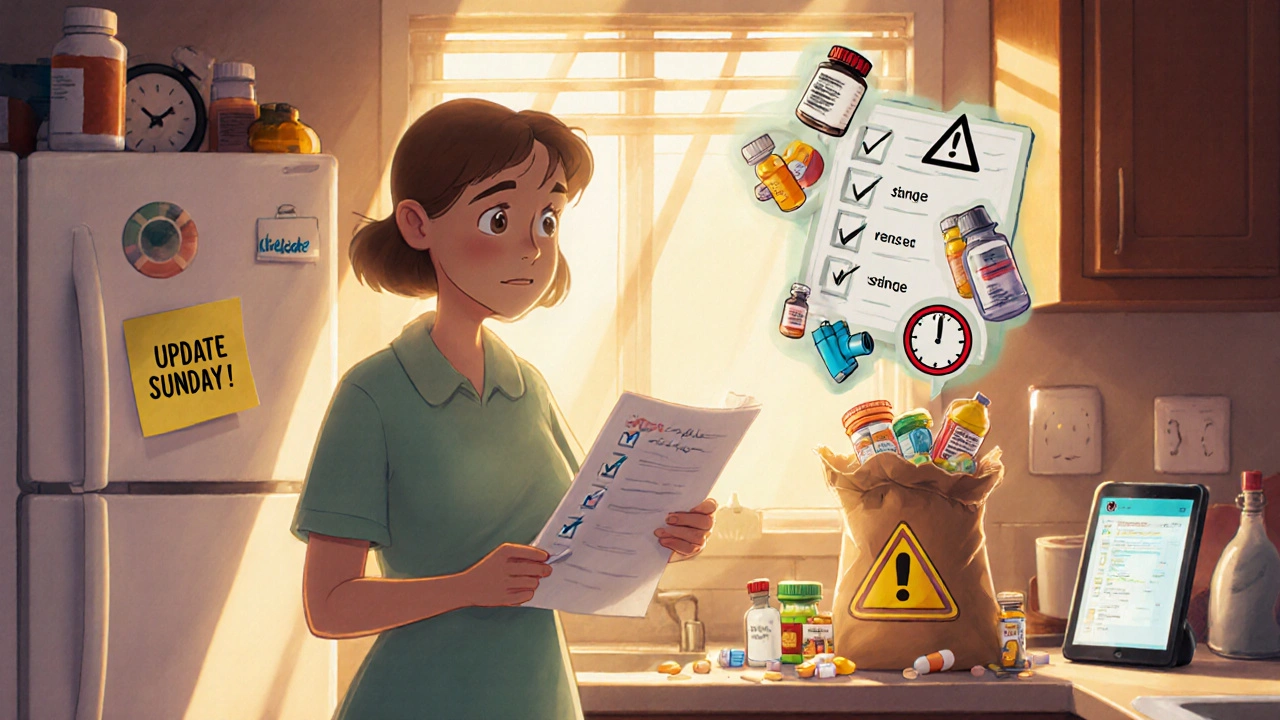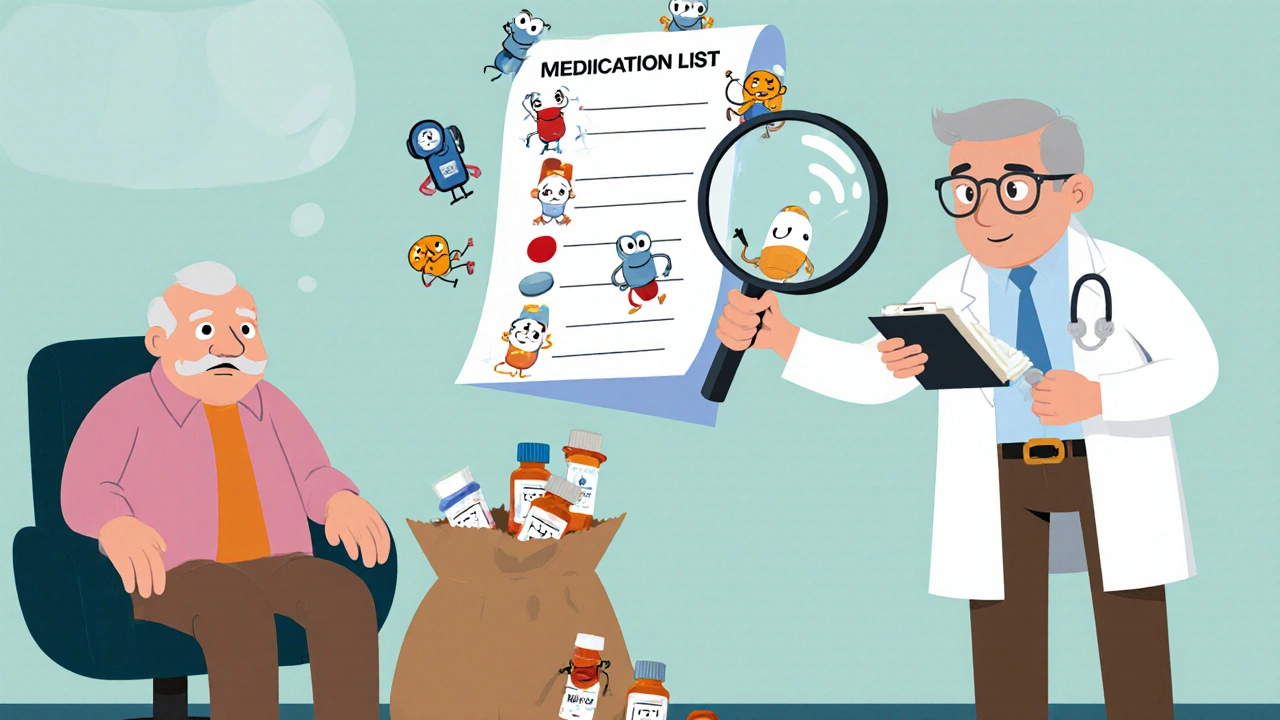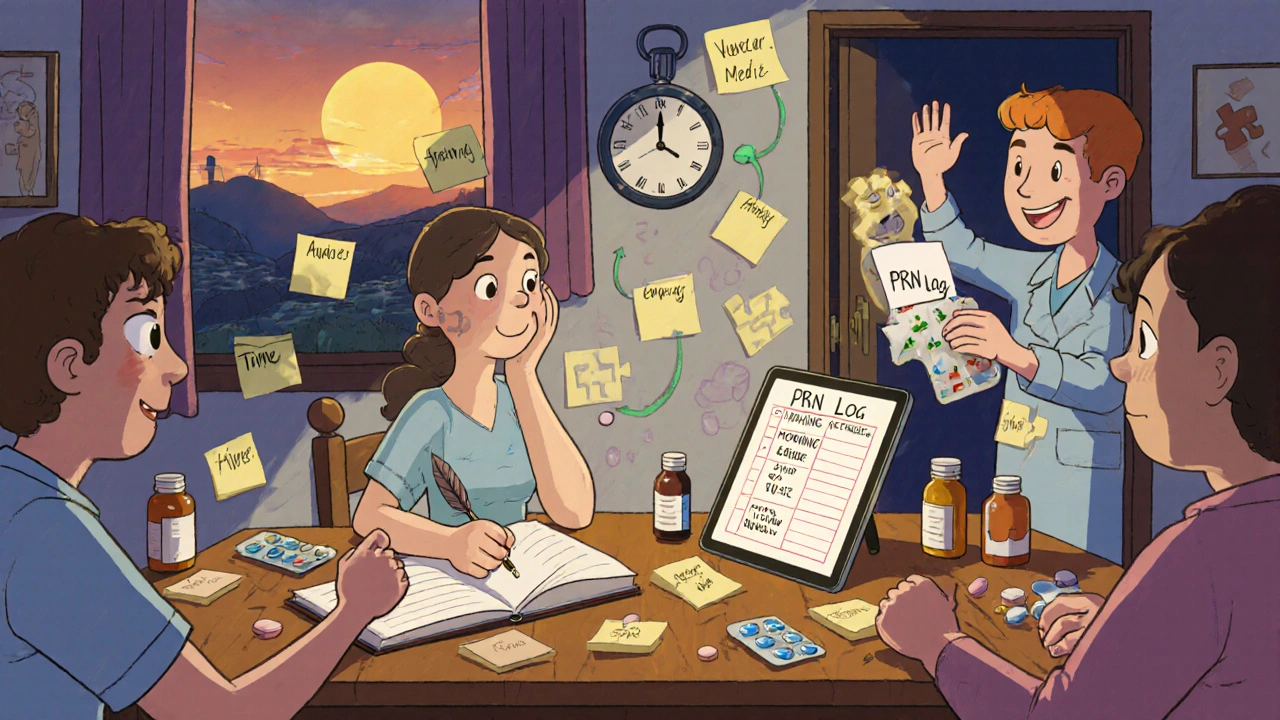
Why a Medication List Matters More Than You Think
Imagine your loved one is rushed to the emergency room after feeling dizzy. The doctors ask what medications they’re taking. You pull out a shoebox full of pill bottles, a napkin with scribbles, and a half-remembered list from last month. That’s not just stressful-it’s dangerous. Over 40% of seniors take five or more medications, and each extra pill raises the risk of a bad reaction by nearly 90%. A clear, up-to-date medication list isn’t a nice-to-have. It’s the difference between getting the right care and ending up back in the hospital.
What to Include on the List
Don’t just write down names. A good medication list answers every question a doctor or pharmacist might have. Here’s what you need for every single pill, patch, or liquid:
- Brand and generic name - Write both. For example: "Lisinopril (Zestril)"
- Dosage - Not "one pill." Say "10 mg" or "5 mL"
- How often - "Twice daily," "every 6 hours," "as needed for pain"
- Purpose - Why are they taking it? "For high blood pressure," "for arthritis pain," "for sleep"
- Special instructions - "Take with food," "don’t crush," "avoid grapefruit," "store in fridge"
- Start date - When did they begin this medication?
- Prescribing doctor - Who wrote the prescription?
- Pharmacy name and number - In case they need to call for refills or questions
- Allergies - List any reactions: rash, swelling, trouble breathing
- Side effects to watch for - Dizziness? Confusion? Nausea? Note what to do if they happen
- Stop date - For short-term meds, like antibiotics or painkillers after surgery
Don’t forget supplements and over-the-counter drugs. People think aspirin or vitamin D are harmless, but they can interact badly with blood thinners or kidney meds. Treat them the same way you treat prescriptions.
Choose the Right Format: Paper, Digital, or Both
Some caregivers swear by paper. Others rely on apps. The truth? Use both.
Paper list is your emergency backup. Keep it printed, laminated, and in a clear plastic sleeve inside your wallet or purse. Hospitals and paramedics know to look for this. It doesn’t need Wi-Fi, batteries, or a password. About 63% of caregivers still use paper because it’s simple and always available.
Digital tools like Medisafe, MyMeds, or even a shared Google Doc work better for complex regimens. If someone takes seven or more medications, digital lists cut error rates by 42%. They can send reminders, track refills, and sync with pharmacies. CVS and Walgreens now offer free automatic updates when prescriptions are filled-no manual entry needed.
Here’s the trick: Use the digital version for daily tracking, and print a clean copy every Sunday. Keep the printed version in your car, your bag, and taped to the fridge. If your phone dies, you’re still covered.
How to Build the List-Step by Step
Don’t try to do this in one sitting. Break it into chunks.
- Gather everything - Go through every drawer, cabinet, and bedside table. Collect every pill bottle, cream tube, inhaler, and supplement jar. Don’t skip the ones that are half-empty.
- Match each item to its prescription - Check the label on the bottle against the original prescription slip. If you don’t have it, call the pharmacy. Ask them to email or print a full list of current meds.
- Fill out the template - Use the FDA’s "My Medicines" form (available online). Write down all 12 details for each medication. Take 10 minutes per pill. Rushing here leads to mistakes later.
- Organize by time of day - Group meds into morning, afternoon, evening, and bedtime. This makes it easier to follow the schedule.
- Create two copies - One for you, one for another family member. Give a copy to the primary care doctor and pharmacist. Keep one in the car and one taped to the fridge.
It’ll take 2-3 hours the first time. That’s normal. After that, it’s just 15 minutes a week to update.

Keep It Updated-Or It’s Useless
A medication list that’s six weeks old is worse than no list at all. Half of all hospital readmissions for seniors happen because the care team didn’t know about a recent change.
Set a rule: Update the list within 24 hours of any change. That includes:
- New prescription from the doctor
- Medication stopped or changed in dosage
- Switched pharmacies
- Added or dropped a supplement
- Discharge from the hospital
Make Sunday evening your update time. It’s quiet, you’re already thinking about the week ahead, and it’s easy to remember. Use a small notebook or sticky notes to jot down changes as they happen during the week. Then transfer them on Sunday.
Use the Brown Bag Method for Doctor Visits
Before every appointment, put every medication-prescription, OTC, supplement-in a brown paper bag. Take it with you. This is the single most effective way to avoid errors.
Doctors and pharmacists see hundreds of patients. They won’t remember what you said last month. But if you walk in with a bag full of bottles, they’ll open them, check labels, and spot problems you didn’t even know about. AARP found 89% of caregivers who used this method said it helped them catch dangerous interactions.
Bring your printed list too. Compare the bag to the list. If something’s missing, ask why. If something’s there that shouldn’t be, ask if it’s still needed.
Handle "As Needed" Meds Without Chaos
"Take as needed for pain" sounds simple-until you’re trying to remember if you gave it yesterday or if it’s safe to give again today. Create a separate PRN log.
Use a small table on the back of your main list:
| Medication | Date | Time | Dose Given | Reason (e.g., pain level) |
|---|---|---|---|---|
| Acetaminophen 500mg | 11/15 | 14:30 | 1 tablet | Pain level 7/10 |
| Lorazepam 0.5mg | 11/16 | 21:00 | 1 tablet | Agitated, couldn’t sleep |
This prevents double-dosing and helps doctors see patterns. If someone’s taking pain meds 5 times a day, it might mean the regular dose isn’t working.

Work With the Pharmacist-They’re Your Secret Weapon
Most caregivers don’t realize pharmacists are trained to catch drug interactions, duplicate prescriptions, and inappropriate meds for seniors. The American Geriatrics Society’s Beers Criteria lists medications that are risky for older adults. Your pharmacist knows this list inside out.
Ask for a free medication review every three months. Bring your full list and brown bag. Ask: "Are any of these meds no longer needed?" "Is there a safer alternative?" "Are any of these interacting?"
One caregiver in Bristol found her mother was taking two different blood pressure pills that did the same thing. The pharmacist caught it during a review-and saved her from a dangerous drop in blood pressure.
Common Mistakes and How to Avoid Them
- Mistake: Only listing brand names. Solution: Always write the generic name too. Pharmacies might switch brands, and you need to know it’s the same drug.
- Mistake: Forgetting supplements. Solution: Treat ginkgo, fish oil, or magnesium the same as prescriptions. They can cause real side effects.
- Mistake: Not updating after hospital discharge. Solution: When your loved one comes home, compare the discharge papers to your list. Call the pharmacy if anything doesn’t match.
- Mistake: Using multiple lists. Solution: Pick one master list. Share it with everyone involved. Don’t let Aunt Linda keep her own version.
- Mistake: Assuming the doctor knows everything. Solution: Doctors see 30 patients a day. They rely on you to give them the full picture.
What to Do When Things Get Overwhelming
If you’re juggling meds for two people, or if the list has more than seven medications, it’s okay to ask for help. Many communities offer free caregiver support programs. In the UK, Age UK and local councils often provide medication management services.
Some pharmacies now offer home visits to help organize meds. Others provide blister packs-pre-sorted pills by day and time. Ask your pharmacist if these services are available.
And if you’re feeling burnt out? That’s normal. You’re not failing. You’re doing something hard. Take a break. Call a friend. Use a reminder app to set a weekly "I’m doing my best" alert.
Final Thought: It’s Not About Perfection
You don’t need a perfect list. You need a consistent one. Even a simple, handwritten list updated weekly is better than no list at all. The goal isn’t to be a nurse. It’s to keep your loved one safe.
Every time you check a pill bottle, write down a dose, or ask a pharmacist a question-you’re not just organizing meds. You’re protecting someone you love.
What’s the most important thing to include on a medication list?
The most important thing is clarity and completeness. Every medication must include the brand and generic name, exact dosage, how often to take it, why it’s being taken, and any special instructions like "take with food" or "avoid alcohol." Missing any of these details can lead to dangerous errors, especially in emergencies.
Should I use an app or stick with paper?
Use both. Digital apps like Medisafe are great for reminders and syncing with pharmacies, but they can fail if the phone dies or the internet goes out. A printed, laminated copy kept in your wallet or purse is essential for emergencies. Many caregivers find the best system is a digital list for daily use and a printed backup for hospitals or paramedics.
How often should I update the medication list?
Update it within 24 hours of any change-whether it’s a new prescription, a dosage change, or stopping a medication. Even small changes matter. Set a weekly reminder (like Sunday evening) to review the list and make sure everything is current. Outdated lists are a leading cause of hospital readmissions in seniors.
Do I need to list vitamins and supplements?
Yes. Vitamins, herbal supplements, and over-the-counter drugs like aspirin or antacids can interact dangerously with prescription medications. For example, fish oil can thin the blood and cause problems if someone is also on warfarin. Treat them the same way you treat prescriptions-list them all.
What should I bring to a doctor’s appointment?
Bring your printed medication list and a brown paper bag with every single medication bottle-prescriptions, supplements, OTC drugs. This lets the doctor or pharmacist physically check what’s being taken, spot duplicates, and catch interactions. It’s the most reliable way to ensure accuracy and prevent mistakes.
Can pharmacists help me organize medications?
Absolutely. Pharmacists are trained to spot drug interactions, unnecessary medications, and dosing errors. Ask for a free medication review every three months. Many pharmacies also offer blister packs-pre-sorted pills by day and time-which can simplify daily routines. CVS and Walgreens now automatically update digital lists when prescriptions are refilled.
What if my loved one is in the hospital?
Bring your printed list and brown bag to the hospital. When they’re discharged, compare the new discharge instructions to your list. If anything doesn’t match, ask the nurse or pharmacist to explain why. Hospital changes are a common source of errors-your list helps prevent them.
How do I handle "as needed" medications?
Create a separate PRN log. Use a small table to record the date, time, dose given, and reason (like "pain level 8/10"). This prevents double-dosing and helps doctors see patterns. For example, if someone takes pain meds 5 times a day, it might mean their regular dose isn’t working.